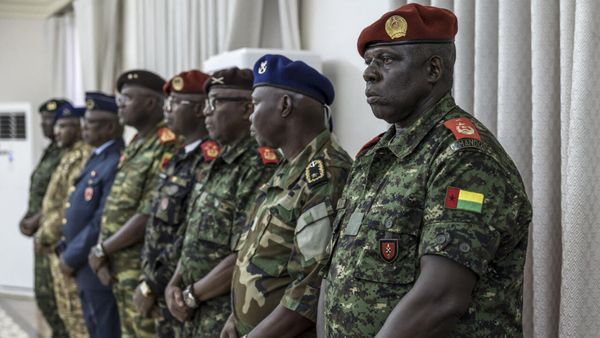
Two years ago the Northern Beaches council replaced the worn-out synthetic turf from a council oval, replacing natural grass with the product sometimes known as astroturf. The council had included in its contract a requirement that it be recycled and not sent to landfill – but federal legislation passed in 2020 meant that it was more difficult to export plastic waste to overseas facilities.
A permit was not granted, so the rolls of old turf sat for nearly 18 months until they were removed earlier this year. They are now in a container in a railway siding, awaiting the completion of a recycling plant capable of separating the various components that make up the product.

The challenges of what to do with worn-out artificial turf, combined with growing concern about microplastics and the likelihood of more extreme weather events, make for a complex debate about its use in Australia. The Alliance for Natural Turf – 16 community groups concerned about artificial turf – has asked the NSW government for a 5-year moratorium on rolling out the product.
They say NSW should employ precautionary principles, warning little is known about the long-term impacts of the microplastics and chemicals that it could shed – including forever chemicals perfluoroalkyl and polyfluoroalkyl substances, also known as PFAS chemicals.
Unknown impacts
In June this year, the NSW government finally released a report by the chief scientist, Hugh Durrant-Whyte, that concluded there were significant environmental impacts from artificial turf but stopped short of recommending a ban. It estimated there were now 181 playing fields using artificial turf in NSW, up from 24 in 2014.
The main concern was potential plastic pollution. Most synthetic sports fields in NSW feature long synthetic blades supported by infill; the most commonly used infill is styrene butadiene rubber (SBR) crumbs sourced from recycled tyres.
The SBR crumb is the material most associated with community concerns about contamination. But the chief scientist says there is insufficient information and a lack of standards about the materials and chemical composition of the synthetic turf itself.
“Expert advice to the review estimated that a synthetic turf field without structures to reduce infill loss will wash tens to hundreds of kilograms of infill per year into stormwater systems or waterways,” the report states.
“The amount of turf fibres lost from a synthetic turf field is likely to be in the hundreds of kilograms per year, with the amount increasing for fields near the end of life or under poor maintenance.”
Active kids v liveable cities
One of the big drivers of increasing installation of artificial turf is population density and increased demands on sporting grounds.
“All councils in Sydney face increasing demand for more sports fields to meet the needs of [a] growing participation in sport,” Sue Heins, the mayor of the Northern Beaches, says.
Northern Beaches council manages 127 sports fields. Six of these are synthetic and allow almost double the playing time of natural grass.
“These new surfaces are more resilient and unlike natural turf, they do not require returfing or weed control and can still be used in wet weather – meaning more play time,” Hein says.
“We have measures in place to prevent any environmental impact of these synthetic surfaces, such as using cork infill instead of rubber and ensuring old synthetic turfs are responsibly recycled at the end of their lifespan”.

But balanced against the more durable surfaces that artificial turf offers are concerns about heat island effects of the artificial product in cities. Unlike natural turf, which stays cool in the sun, artificial grass heats up quickly because it absorbs more solar radiation.
“It’s a material that, like polished metal slides, can cause severe burn injuries,” says Sebastian Pfautsch, an associate professor of urban management and planning at Western Sydney University.
His research has shown that synthetic turf in playgrounds can heat up to temperatures greater than 80C, even when the ambient temperature is less than 30C. Sometimes sprinkler systems are needed to cool the surface, which in part defeats the water savings associated with artificial turf.
A spokesperson for Sydney’s Inner West council, which has four synthetic fields, says it uses an organic infill to help reduce the heat during hot weather. It was also aiming to plant more trees to reduce the heat island effect.
Recycling synthetic turf
Following the restrictions on exporting plastic waste, Australian artificial grass manufacturer Tuff Turf has partnered with Sustainability Victoria to build a recycling plant at Barnawartha, near the Victoria-NSW border.
Re4orm is due to open early next year, and according to its director, Trent Cummings, some 2m square metres of artificial turf from Sydney playing fields will be replaced in the next six to eight years.
The purpose-built facility will separate the turf into individual components, reducing waste to landfill and significantly decreasing the C02 emissions released in landfill, Cummings says.
The first stage is to separate the sand, crumb (usually rubber) and “gunk” from the plastic matting. The sand and rubber is then cleaned for reuse.

The mat is then shaved of the grass blades so the plastic grass can be melted down into polyurethane pellets and stabiliser, which can be used in products such as boards for landscaping and seats.
Cummings says Re4orm’s service will work on all synthetic turf. The backing, which makes up about 3-4% of the weight of the product, is more complex, but will also be recycled into latex and other plastics.
“We need the government to do more research to create products using recycled material,” says Cummings.
Most of the shockpads underneath the turf are now imported, but there is no reason why it can’t be made here using recycled inputs, he says.
The old artificial turf from the Northern Beaches will be one of the first artificial surfaces to be put through Re4orm’s process. But in the meantime, councils are likely to face increasing questions from their communities about the environmental safety of the product.







